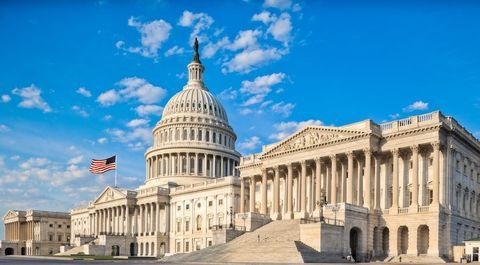President Biden Signs American Rescue Plan Act of 2021, sets in motion historic expansions of the ACA, Medicaid and other important health policy related changes among sweeping pandemic relief provisions
Client Alert | 8 min read | 03.12.21
The American Rescue Plan Act of 2021, or COVID-19 bill, was signed into law by President Biden on March 11, 2021. It passed the U.S. House originally on February 27, 2021, by a vote of 219 to 212, was amended by and passed the U.S. Senate on March 6, 2021, by a vote of 50 to 49, and the amended and reconciled bill was passed by the U.S. House on March 10, 2021 by a vote of 220 to 211. The 242-page bill provides a total of $1.9 trillion in economic stimulus related to the COVID-19 crisis and includes stimulus checks for Americans, renewed unemployment benefits, employment related provisions, tax related provisions, education related provisions, child benefits related provisions and provisions related to the COVID-19 pandemic at large and health care in general. The purpose of this Client Alert is to provide a summary of the health care provisions of the new law.
I. COVID-19 Vaccines, Testing, Mitigation Measures
The American Rescue Plan provides nearly $91 billion to the U.S. Department of Health and Human Services (HHS) for pandemic-related activities, including research, development, manufacturing and distribution of vaccines, therapeutics, diagnostic testing, contact tracing, and expanding the health care workforce. More specifically it provides:
- $7.5 billion for the Centers for Disease Control and Prevention (CDC) to prepare, promote, administer, monitor and track vaccines;
- $7.6 billion for vaccination, testing and associated activities at community health centers;
- $7.7 billion for HHS to establish, expand and sustain a public health workforce;
- $47.8 billion for HHS activities to detect, diagnose, trace and monitor COVID-19 infections, directing HHS to implement a national strategy for testing, contact tracing, surveillance and mitigation;
- $6.1 billion for research, development, manufacturing, production and purchase of vaccines, therapeutics and ancillary medical products; and
- $10 billion to support the production, purchase and distribution of critical materials and equipment under the Defense Production Act (DPA) for the specific use of combatting the COVID-19 pandemic.
Additionally, the bill sets aside $50 billion for the Federal Emergency Management Agency’s (FEMA) Disaster Relief Fund in order to reimburse state and local governments for COVID-19-related expenses; these funds will remain available through fiscal year (FY) 2025.
II. Affordable Care Act Related Provisions
Expanded access to health care coverage is a critical element of the Biden Administration’s response to the COVID-19 pandemic’s health and economic challenges. In addition to the recent special enrollment period that re-opened enrollment for exchange plans, the legislation temporarily expands eligibility and increases federal financial support for individuals accessing coverage through the Affordable Care Act (ACA). The more generous subsidies to purchase coverage solves a key access challenge—improving the affordability of ACA coverage during a time of crisis.
Additionally, the American Rescue Plan includes significant changes to the Medicaid program, including higher federal matching funds to states to promote home- and community-based services; allowing states the option to cover 12 months of post-partum coverage for new mothers; requiring coverage of COVID-19 vaccines and treatment; expanding the existing Medicaid option for states to cover COVID-19 testing for the uninsured; and new additional incentives for states that have not yet expanded their Medicaid program to low-income adults under the ACA to close the coverage gap between traditional Medicaid and eligibility for the ACA’s premium subsidies. The legislation also provides additional funding for mental health and substance use disorder benefits. The pandemic has highlighted the demand for more mental health and substance use disorder services.
Finally, the American Rescue Plan also subsidizes premiums for COBRA continuation coverage.
- ACA Expansion and Premium Subsidies:
- Extends ACA subsidies to people who, based on income, do not currently qualify for 2021 and 2022;
- Increases ACA subsidies for lower-income people who already qualify for 2021 and 2022;
- Provides maximal ACA subsidies for individuals that receive unemployment benefits in 2021;
- Prevents taxpayers who misestimated their income in 2020 from having to repay excess premium tax credits at tax time; and
- Creates a “special rule” regarding premium tax credit eligibility for those who receive unemployment compensation during 2021. If someone receives (or is approved to receive) unemployment benefits during 2021, their income will be treated as no higher than 133 percent of the federal poverty level, allowing individuals who receive unemployment benefits to receive maximal subsidies for ACA coverage, including no-premium coverage.
- Includes $20 million for state-based marketplace modernization aimed at helping speed the adoption of these changes; these funds will be available through September 30, 2022.
III. Medicaid Provisions (changes to Medicaid financing and eligibility rules)
- Expansion Incentive
- Provides an incentive for states that have not already done so to expand Medicaid by temporarily increasing the state’s Federal Medical Assistance Percentage (FMAP) for their base program by 5 percentage points for two years. If a state expands during the PHE, that state will receive both the COVID-related 6.2 percentage point FMAP and the new 5-percentage-point increase. States choosing to expand are required to maintain coverage levels to access the FMAP increase, including the newly established requirement to cover COVID-19 vaccine and treatment (summarized in greater detail below).
- Postpartum Coverage Expansion
- Gives states (for 5 years) the option to extend Medicaid and Children’s Health Insurance Program (CHIP) eligibility to pregnant individuals for 12 months postpartum. States choosing this option must provide the full Medicaid benefit for pregnant and postpartum individuals during the 12-month postpartum period.
- Maintaining Medicaid DSH During PHE
- To address an unintended consequence of the temporary increase in the FMAP and state DSH spending, the bill requires that CMS recalculate the annual DSH allotments for any year the temporary COVID-19-related FMAP increase applies to ensure that the total DSH payments a state would make (including federal and state shares) is equal to the DSH payment amount the state would have made in the absence of the temporary FMAP increase. This DSH allotment recalculation is retroactive to coincide with the temporary FMAP increase that was initiated last year and will end at the beginning of the fiscal year after the public health emergency (PHE) has ended.
- Coverage of Vaccines for Medicaid and CHIP Beneficiaries
- Requires Medicaid and CHIP coverage of COVID-19 vaccines and treatment without beneficiary cost sharing. Vaccines and vaccine administration costs will be matched at a 100% FMAP until one year after the PHE has ended.
- States also have the option to provide coverage to the uninsured for COVID-19 vaccines and treatment without cost sharing at 100% FMAP.
- FMAP, Coverage or Funding Improvements
- Provides temporary one-year federal medical assistance percentage (FMAP) increase to improve home-and-community-based-services as well as FMAP increases for services provided through the Urban Indian Organizations and Native Hawaiian Health Care Systems.
- Mental Health and Substance Use Disorders
- Allocates $3.5 billion for block grants addressing mental health and substance use disorders; additional funds are allocated for grants addressing behavioral health disorders in the health care workforce, community-driven overdose prevention and harm reduction and other behavioral health needs, and $100 million for behavioral health workforce education and training.
- Creates new optional Medicaid coverage (for the five years following enactment) and an associated $15 million for planning grant funds and enhanced FMAP for states to develop mobile crisis intervention services for individuals experiencing a mental health or substance use disorder crisis.
- Directs $80 million to Pediatric Mental Health Services programs to provide grants to states, subdivisions of states, Indian tribes and tribal organizations to support mental healthcare telehealth access programs if such governmental entities match at least 20 percent of the federal funding.
- Provides $420 million to Community Behavioral Health Clinics, which help integrate behavioral health with physical healthcare, increase consistent use of evidence-based practices and improve access to high-quality care.
- COBRA Subsidies
- Effective April 1, 2021, through September 30, 2021, the bill allows for subsidies of 100 percent of the cost of premiums for COBRA continuation coverage for workers who are involuntarily terminated or have reduced hours; these individuals will have an extended period to enroll. This subsidy will be treated as an advance refundable payroll tax credit and will not count towards an individual’s gross income.
IV. Funding for State, Local, Territorial, and Tribal Governments
The bill provides an additional $350 billion for states, territories, and Tribal governments to mitigate the fiscal effects stemming from the PHE. This allocation includes creation of a “Coronavirus Capital Projects Fund” to provide $10 billion for states, territories, and Tribal governments to conduct critical capital projects directly enabling work, education, and health monitoring in response to the COVID-19 PHE.
V. Provider Relief and Reimbursement Measures
The American Rescue Plan provides additional but modest and narrowly targeted provider relief, primarily for safety-net and rural hospitals and providers as described below.
- Additional Financial Relief for Rural Providers
- The bill adds $8.5 billion to the Provider Relief Fund, targeted specifically to reimburse rural health care providers for health care-related expenses and lost revenues attributable to COVID–19. It also allocates $500 million to the Department of Agriculture to award grants to eligible entities, including certain rural hospitals, based on needs related to the COVID-19 pandemic; uses include COVID-19-related expenses and lost revenue to maintain capacity, such as increasing capacity for vaccine distribution or telehealth capabilities.
- Skilled Nursing Facilities (SNFs)
- The bill provides $450 million to support SNFs in protecting against COVID-19. Specifically, the bill:
- Allocates $200 million for the development and dissemination of COVID-19 prevention protocols in conjunction with quality improvement organizations; and
- Allocates $250 million to states and territories to deploy strike teams that can assist SNFs experiencing COVID-19 outbreaks; state-based strike teams can assist SNFs with clinical care, infection control or staffing during the COVID-19 emergency period up to one year immediately after the PHE ends.
- The bill provides $450 million to support SNFs in protecting against COVID-19. Specifically, the bill:
- Re-establishes Hospital Minimum Medicare Wage Index:
- For purposes of Medicare hospital payments, the bill re-establishes the Minimum Medicare Wage Index “floor” for hospitals located in all-urban states (i.e., states where there are no rural areas or where there are no hospitals classified as rural). This change would apply for discharges occurring on or after Oct. 1, 2021.
VI. Funding for the Department of Health and Human Services Office of Inspector General
The American Rescue Plan appropriates $5 million to the HHS Office of Inspector General (OIG) for fiscal year 2021 for oversight of activities supported with funds appropriated to HHS to prevent, prepare for, and respond to COVID-19 both domestically and internationally. This appropriation bolsters the ability of HHS OIG to monitor the potential fraud and abuse of federal funds used to address the COVID-19 pandemic.
VII. Elimination of Medicaid Drug Rebate Cap, Inclusion of COVID-19-Related Drugs in Medicaid Rebate Program
The bill eliminates, effective January 1, 2024, the Medicaid drug rebate cap (under current law, set at 100% of the average manufacturer price); it also allows outpatient drugs used for COVID-19 prevention or treatment to be included in the Medicaid Drug Rebate Program.
Contacts
Insights
Client Alert | 2 min read | 12.29.25
FYI – GAO Finds Key Person “Available” Despite Accepting Employment with a Different Company
GAO’s key personnel rule is well-known—and often a source of frustration— amongst government contractors. Proposed key personnel who become “unavailable” prior to contract award—especially where they have accepted employment with a different company—may doom an offeror’s proposal by rendering it noncompliant with solicitation requirements. But GAO’s recent decision in FYI – For Your Information, Inc., B-423774, B-423774.2 (Dec. 19, 2025) provides some potential relief from that rule.
Client Alert | 4 min read | 12.29.25
More Than Math: How Desjardins Recognizes AI Innovations as Patent-Eligible Technology
Client Alert | 10 min read | 12.24.25
Client Alert | 3 min read | 12.24.25
Keeping it Real: FTC Targets Fake Reviews in First Consumer Review Rule






